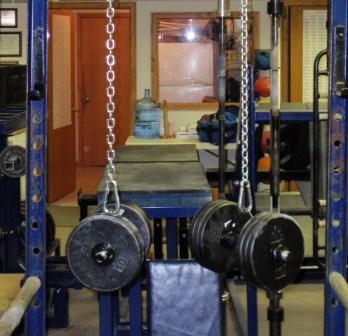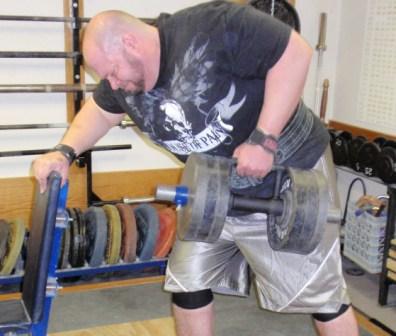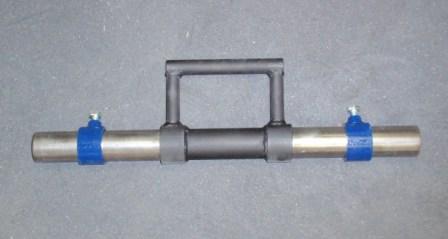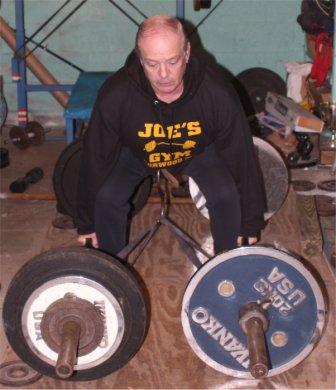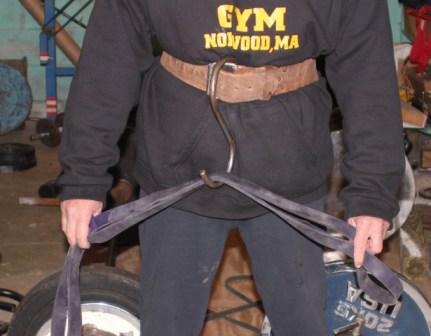by Thom Van Vleck
As we are all aware, Big Al has created a contest where we are supposed to write a story on a training “secret” we have that would benefit others. This was a difficult thing for me to do as I don’t keep secrets. I share everything I have with anyone willing to listen. I’ve always been that way. So I really don’t have any secrets…..but I looked at what I do and came up with something I do almost every workout. It’s something I think has allowed me to compete at a high level as I head into my 47th year and 34th as a weightlifter.
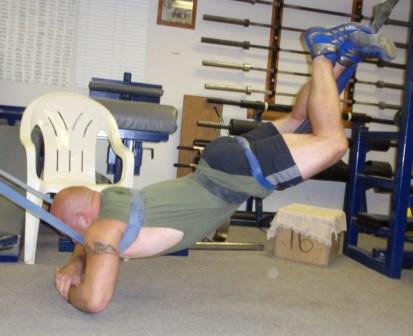
Al & Chad executing a very complicated two man stretch of the spine. Now really, do you have the time for this or for that matter would you be caught dead in such a compromising position???
A healthy back is essential to weight training. If you lift weights and have never hurt your back, you are either a very good liar, you’ve never pushed yourself, or you just started yesterday. Back injuries are a part of the sport. Especially if you are a master lifter over 40, and most USAWA lifters are over 40…..some WELL over 40! If you’ve had a back injury, you’ve probably tried to rehab it in different ways. Some of these with drugs like anti-inflammatories, muscle relaxants, or pain medication. You may have seen a doctor, a chiropractor, a massage therapist, or maybe an Osteopath. You’ve probably been given stretching exercises, yoga exercises, or whatever the latest fad is. You may have went so far to invest in some equipment, such as a stability ball, rubber bands, or went really expensive with a reverse hyper, or an inversion table! You also may have found some really complicated and difficult ways to do what all these things try and do…..decompress your spine.
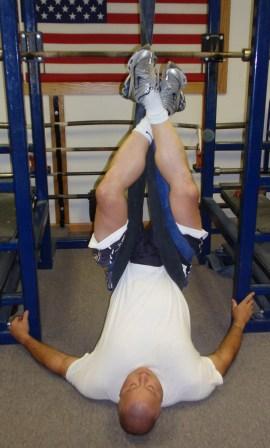
Now, don't get me wrong, I've had a little fun at Al & Chad's expense. These are great exercises, but their problem is the practicality of doing them every workout.
I’m going to share two very simple and basic stretches that require very little investment of time or money. They can be very helpful in rehabbing a bad or injured back, but I would encourage you to do these EVERY TIME YOU WORK OUT to help keep your back healthy and prevent injuries!
First, there’s the good ol’ bar hang. Sure, we’ve all heard of it and probably done it. You hang from a chin up bar. I know what your are thinking. “Geez, Thom, I thought you were going to give us some great secret! Well, I am. Sometimes the best things are the simplest things and they are the things we tend to ignore. Like squats, which is a really great exercise, and yet there’s been a hundred ways developed to avoid squatting each one more complicated than the last! Now, here is a real secret. When you hang from the bar, put your heels on something about a foot or two in front of you. Why? Because you want to tilt your hips forward. This will straighten out the lower spine. Otherwise, if you just hang there the weight of your legs will pull you hips back and bend your spin inward in your lower back. As a result, the weight of your legs will bend your spine and true decompression does not occur! You also need to relax everything except your grip (and another thing, this can be a tremendous grip exercise, an added benefit). If you can’t hang for at least a minute, then use straps until your grip gets to where you can. Total investment: A chin up bar.
Now, the only problem with the bar hang is it only decompresses the lower half of your spine. While this is where most injuries occur, it is only half the picture. Plus, most guys don’t think much about this, but your spine is more than your back, it’s you neck as well! Many weight lifters will injure their neck and it’s also an area that gets a lot more abuse than you realize. Why, because it holds up your fat head! Seriously, the head is always FORWARD on the neck so any time you are not lying down with your neck supported it is being leveraged with pressure from that bowling ball that’s sitting on top if it! Also, many of us will injure our neck at some point lifting, playing sports, or doing something stupid (most guys that train tend to be risk takers….admit it, you’ve done something stupid with your body). And as for the upper back, it gets injured much more rarely than the lower, as a result, how often do we decompress our upper back and neck?
So, this leads me to the second “secret” exercise. Like I said before, if you got loads of cash, you can spend it on a personal massuese and an inversion table….but if you don’t this will work just as well. Maybe better because it is so easy you will do it more often!
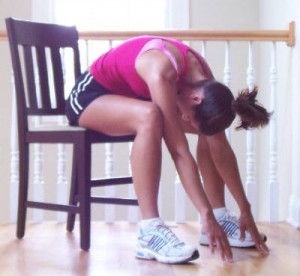
Neck and upper back stretch....and yes, I used a photo of a pretty girl to "sell" this and influence the vote! Really, would you want to see me doing this or her! Vote for my article!
The second exercise involves sitting in a chair and letting your head and shoulders fall between you knees. There’s an added benefit that if you get good at this exercise you can also use it to kiss your rear goodbye when you do some of the aforementioned “stupid” stuff. But seriously, you sit in a chair and let your arms fall between you legs while sitting right on the edge of the chair. I was taught to let my arms fall relaxed and then let my head fall forward relaxing it as much as possible. If you do this enough you can fell you vertebrae relax. I now fell a “pop-pop-pop” in my upper back when I do this. Again, you want to stay in this position for about a minute. I also do the added exercise of doing some head rolls once I sit back up, this will seem to always pop my neck a couple times. Total investment: a chair.
So, there you have it. Two exercises, two minutes, cheap, easy and I would argue for the amount of time and money invested you will do your spine more good than any of that other stuff. Call this, 2 ounces of prevention!
